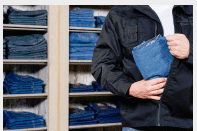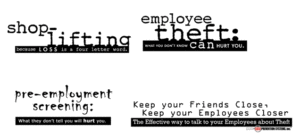 You have (or I hope you have) read the last article on preventing check fraud. It’s a great way to protect your business from a different avenue of fraud. Another, much more popular and prevalent scheme is credit card fraud. The United States lags far behind the other major countries in the fight against credit card fraud. We’ve only just begun adopting chip and pin technology and it will be several more years before we see magnetic strips become a relic of the past. So exactly how can you identify and prevent a fraudulent change from happening in your store and how exactly do you lose money on these transactions?
You have (or I hope you have) read the last article on preventing check fraud. It’s a great way to protect your business from a different avenue of fraud. Another, much more popular and prevalent scheme is credit card fraud. The United States lags far behind the other major countries in the fight against credit card fraud. We’ve only just begun adopting chip and pin technology and it will be several more years before we see magnetic strips become a relic of the past. So exactly how can you identify and prevent a fraudulent change from happening in your store and how exactly do you lose money on these transactions?
Credit card fraud is the one of the biggest, single fraud scheme affect my stores. While the criminals evolve their tactics quite often, there are some general rules you can follow to identify possible fraudulent transactions.
- Large Dollar Gift Card Purchases| Normally, a legitimate customer will not purchase 3 $500 in back-to-back transactions with 8 different credit cards. This is a red flag and should involve management immediately.
- Multiple Transactions with Multiple Credit Cards| This is another red flag that could help you identify criminal activity. The average American owns about 3 credit cards. If you have an individual using 5-8 credit cards to make several big ticket purchases, then you’re probably dealing with some fraud.
- The Credit Card Lacks the Eagle Hologram|Holograms are hard to fake (although I’ve seen some really good ones). Often, the counterfeiters will skip over this step, so I always look for the eagle.
- Typos| Since a lot of counterfeit cards come from manufacturers overseas, every now and then, you can spot a typo on the bank’s name, or even the credit card company (I’ve personally seen “MasterCard” about a dozen times.)
- Verify ID on all purchases over $X. Now this one is tricky. About 3 years ago, this was an easy, sure fire way to spot a fraudster, as the ID and the card name would not match. Over the past 18 months, we have seen these groups become highly sophisticated in this area. They will now very often, imprint the actual name of the criminal on the card. They also imprint the card with an account number that is not the account number that is embedded in the magnetic strip, which makes identifying the card as fake at the point of sale almost impossible.
So now you have a few best practices to use in your fight against credit card theft, but you may still be asking yourself, “Why should I care? Then bank covers the loss to the customer anyway.” While that statement is absolutely true, the banks will then issue a “charge-back” to the retailer that accepted the fraudulent purchase. This means you can be out thousands upon thousands of dollars if you’re not proactive in your approach to identify and prevent fraudulent credit card purchases in your store.
Essentially, what that means is the criminal impacts two people; the customer that is a victim of identity theft and the retailer that must then cover the cost of the transaction. For a large corporation, it may not be a big deal to dole out tens of thousands of dollars per month in chargebacks, but to a small business owner, even a few hundred could make the difference between being in the red, or black.
My best advice to you is that you follow the guidelines above and update your POS systems to accept the new chip and pin technology. Hopefully, in the coming years as the old tech is phased out and the more secure chip technology takes over, brick and mortar credit card fraud will be a distant memory. (Online fraud, however will take center stage… but I’ll save that for next time.)
 You know, we talk about the thousands of ways you, the small business owner, loses money to thieves constantly. Most of that is centered on shoplifters and boosters stealing your merchandise. We talk about that for good reason… it’s one of the biggest financial impacts to your business if left unchecked. However, there are so many other ways that your business can be targeted by criminals and some of them may appear so legitimate, that you would have no idea you were a victim for weeks. In that time, the criminal is long gone and you’re left paying for that theft out of your pocket. One area of training that is often overlooked in retail is check fraud. I’ll give you some advice on how to identify this in your store and protect yourself from vulnerability.
You know, we talk about the thousands of ways you, the small business owner, loses money to thieves constantly. Most of that is centered on shoplifters and boosters stealing your merchandise. We talk about that for good reason… it’s one of the biggest financial impacts to your business if left unchecked. However, there are so many other ways that your business can be targeted by criminals and some of them may appear so legitimate, that you would have no idea you were a victim for weeks. In that time, the criminal is long gone and you’re left paying for that theft out of your pocket. One area of training that is often overlooked in retail is check fraud. I’ll give you some advice on how to identify this in your store and protect yourself from vulnerability.
 What is the solution to shoplifting and employee theft?
What is the solution to shoplifting and employee theft? Employee theft is a common and costly problem in retail. Some businesses’ are reporting that, for the first time, internal pilferage has now surpassed external. There are many ways to control and manage internal theft. But, one of the most effective ways is often overlooked. Stop it before it starts.
Employee theft is a common and costly problem in retail. Some businesses’ are reporting that, for the first time, internal pilferage has now surpassed external. There are many ways to control and manage internal theft. But, one of the most effective ways is often overlooked. Stop it before it starts. According to the National Retail Federation-
According to the National Retail Federation- Do you REALLY know how to stop shoplifters? I mean, really know? Your Checkpoint System is only half of the strategy. You spent the money, put the labor/time into using labels and tags but after the newness wears off, are you still having more losses than you want?
Do you REALLY know how to stop shoplifters? I mean, really know? Your Checkpoint System is only half of the strategy. You spent the money, put the labor/time into using labels and tags but after the newness wears off, are you still having more losses than you want?
 There’s been some news swirling around the LP world for a few weeks now about California and some new laws that the state has passed. Basically, the state raised the threshold for a felony theft to $950. The article hinted that shoplifting has increased in the major retail stores and calls for shoplifting cases have increased by 25% to the LAPD. The article blamed the new legislation for this. Here’s a link to that article if you’d like to read it. (
There’s been some news swirling around the LP world for a few weeks now about California and some new laws that the state has passed. Basically, the state raised the threshold for a felony theft to $950. The article hinted that shoplifting has increased in the major retail stores and calls for shoplifting cases have increased by 25% to the LAPD. The article blamed the new legislation for this. Here’s a link to that article if you’d like to read it. ( It’s no big secret that I can’t stand a thief; I did make a career out of catching them. Shoplifters really get under my skin, but employee theft really fires me up. You put people to work, give them opportunity to grow and instead of putting in the long hours, hard work and dedication needed to move forward, they steal from you. They betray your trust, slap you in the face and take money out of your pocket and food off your family’s table. Will you ever stop employee theft completely? Probably not. You can, however, minimize the risk.
It’s no big secret that I can’t stand a thief; I did make a career out of catching them. Shoplifters really get under my skin, but employee theft really fires me up. You put people to work, give them opportunity to grow and instead of putting in the long hours, hard work and dedication needed to move forward, they steal from you. They betray your trust, slap you in the face and take money out of your pocket and food off your family’s table. Will you ever stop employee theft completely? Probably not. You can, however, minimize the risk. Whether you’re a small one store business, or a large chain store, loss prevention awareness training for your teams cannot only protect against criminal acts, but also make a direct and positive impact on your bottom line. There is an inherent value in awareness training that lots of managers just don’t take advantage of. The core of any successful loss prevention program is not how many shoplifters are caught, nor is it how many employees were arrested; it’s training and awareness of your store teams. We are called loss “prevention,” not loss “reaction,” right? So how do you persuade your managers to see the value?
Whether you’re a small one store business, or a large chain store, loss prevention awareness training for your teams cannot only protect against criminal acts, but also make a direct and positive impact on your bottom line. There is an inherent value in awareness training that lots of managers just don’t take advantage of. The core of any successful loss prevention program is not how many shoplifters are caught, nor is it how many employees were arrested; it’s training and awareness of your store teams. We are called loss “prevention,” not loss “reaction,” right? So how do you persuade your managers to see the value?